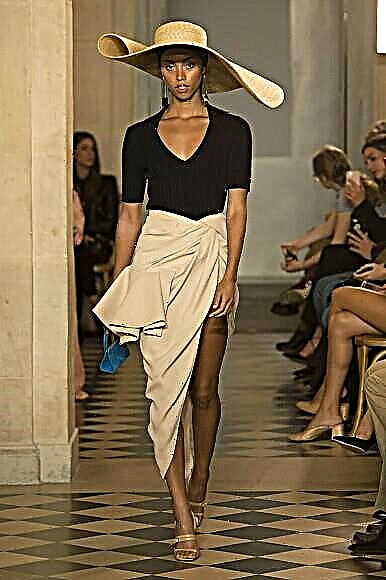Share
Pin
Tweet
Send
Share
Send
It’s so great that emphasizing the pretty roundness is now considered good tone and taste. Emphasize the inner beauty and special light of the future mother with stylish clothes and accessories.
Renaissance fashion in the 15th century became more free and human.With the exception of Catholic Spain, where corset and iron hoops in skirts reigned in fashion. And for especially important ladies, they cut and sewed an outfit in such a way that the removable part of the corsage (it was called the "stomaker") could conveniently lie on top of the abdomen. Such oversized dresses with richly embroidered stomakers were worn, for example, by Queen Margarita, the wife of King Philip of Spain.

Hide or not?
A lace embroidered apron was also used as a clothing item for pregnant noble ladies. He covered the floors of a dress or jacket no longer converging on his stomach. By the way, “pregnant dresses” for attending balls and receptions were often embroidered with pearls - he was a symbol of St. Margarita, the patroness of childbearing. But perhaps these are almost the only examples of clothes of the time, specially designed for expectant mothers.Since about the 17th century, fashion has emerged from the "home circle" and has become aristocratic and secular. Ladies of high society lead a free life, wear loose dresses and in any position, including in an interesting one, feel comfortable.
In the Baroque and Rococo times, women's clothing was incredibly adorned with vibrant and artificial flowers, ribbons, and there were so many layered skirts and cuts that, with all this pomp, the pregnancy was completely invisible and did not matter from the point of view of fashion.
The empire style became the calmest for expectant mothers: the waist was not constrained, and the lungs, the folds falling down from the chest, hid the plump figure. Such a richly embroidered dress was worn during pregnancy by the famous Duchess of Devonshire, a trendsetter known in many picturesque images.And as always, the history of fashion was not without a curiosity: at the end of 1792 a strange and comical fashionable “accessory” appeared in England - an underlay metal belly imitating pregnancy. It was worn by women of all ages and social status, married and unmarried. Such a fashion was ridiculed, was not approved, especially by the royal family, however, it lasted a short time.
Ahead was the century of XIX, the century of the thinnest, pulled in a corset of waists and magnificent skirts. Undoubtedly, this was far from useful for the mother and the unborn child, but the thin waist, the main criterion for the beauty of that time, was too attractive, and therefore many women preferred to risk their health, both their own and the child, and until the fifth or sixth month so tight laced up a corset that others did not know about pregnancy. In recent months, they still wore a special corset, with extra lacing on the sides and stomach. Such a corset was quite comfortable, and sometimes a woman did not remove it even during childbirth.
Maternity Fashion
Only in the twentieth century, clothes for pregnant women became part of the fashion industry. Pregnancy has ceased to be the usual state of a woman and has turned into an event. Today, in the XXI century, the expectant mother can remain fashionable and stylish at any time. Even wedding dresses are created especially for pregnant women. From soft "breathing" fabrics, trousers and skirts with tucks, shirts and dresses with an altered line of the chest and hips are sewn. These things will "grow" with the expectant mother.Wrap dresses and blouses, trousers and skirts with ties or elastic bands - these clothes look great for all nine months.Undoubtedly, in a stylishly dressed expectant mother there is a special unique charm. And not only on weekdays - is it really worth giving up beautiful clothes and going out in these happy nine months ?!
Update your wardrobe with comfortable maternity models for every day fromBurda 1/2015to look even more beautiful!
In addition, models for pregnant women can be found in the magazines:
- Burda 8/2004
- Burda 6/2010
- Burda 2/2012
The article was published on the basis of the journal "Good advice" 8/2014
Photo: PR
Material prepared by Julia Dekanova
Share
Pin
Tweet
Send
Share
Send






